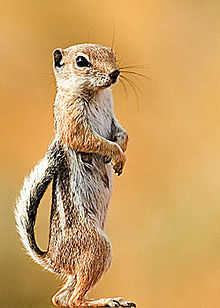Ammospermophilus
| Antelope squirrels Temporal range: Late Miocene - Recent |
|
|---|---|
 |
|
| Scientific classification | |
| Kingdom: | Animalia |
| Phylum: | Chordata |
| Class: | Mammalia |
| Order: | Rodentia |
| Family: | Sciuridae |
| Tribe: | Marmotini |
| Genus: |
Ammospermophilus Merriam, 1892 |
| Species | |
A. harrisii
A. insularis
A. interpres
A. leucurus
A. nelsoni
Antelope squirrels or antelope ground squirrels of the genus Ammospermophilus are sciurids found in the desert and dry scrub areas of south-western United States and northern Mexico. They are a type of ground squirrel and are able to resist hyperthermia and can survive body temperatures over 40 °C (104 °F).
There are currently four recognised species in the world, with one subspecies:
All are somewhat similar in appearance and behavior. They are around 14–17 centimetres (5.5–6.7 in) long with a 6–10 centimetres (2.4–3.9 in) tail, and weigh 110–150 grams (3.9–5.3 oz). The tail is somewhat flattened. They have a single white stripe on both flanks and none on the face. They live in burrows, which they dig for themselves. They are diurnal, and do not hibernate (though they become less active during the winter), so they are fairly easily seen.
All the antelope squirrels share a common white stripe along the lateral sides from the shoulder to the hip similar to chipmunks. However, unlike chipmunks, these characteristic white stripes do not extend onto the head of the animals. The tails of antelope squirrels are often arched forward over their back. In the United States, these ground squirrels are found in the dry, desert like regions of the southwest. The different members of the genus Ammospermophilus have unique adaptations that allow them to overcome the extreme heat of the day and the low temperatures of the night. All antelope squirrels burrow into the ground for shelter, however not all are social creatures. Each antelope squirrel has a white ventral surface with little variation.
The four unique species of the genus Ammospermophilus can be distinguished by some variations in size, weight, and appearance.
...
Wikipedia
